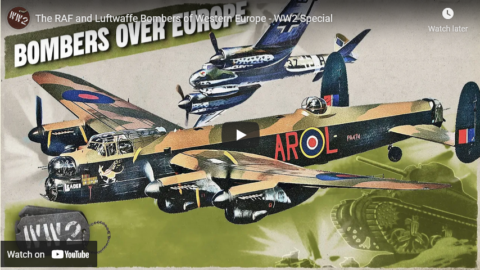World War Two
PUblished 22 Jun 2021What aircraft are being sent out by commanders like Hermann Göring and Arthur Harris to blitz and firebomb enemy cities? Watch the video to learn the specs of the Handley Page Halifax, Avro Lancaster, Junkers Ju-88, Dornier Do-17, Dornier Do-217, and Heinkel He-111 as they fly in their respective 1,000 Bomber Raids and Baedeker Blitz.
Join us on Patreon: https://www.patreon.com/TimeGhostHistory
Or join The TimeGhost Army directly at: https://timeghost.tvGet Collectibles here: https://timeghost.tv/collectibles/
Follow WW2 day by day on Instagram @ww2_day_by_day – https://www.instagram.com/ww2_day_by_day
Between 2 Wars: https://www.youtube.com/playlist?list…
Source list: http://bit.ly/WW2sourcesHosted by: Indy Neidell
Written by: Indy Neidell, Marlon William Londoño
Director: Astrid Deinhard
Producers: Astrid Deinhard and Spartacus Olsson
Executive Producers: Astrid Deinhard, Indy Neidell, Spartacus Olsson, Bodo Rittenauer
Creative Producer: Maria Kyhle
Post-Production Director: Wieke Kapteijns
Research by: Marlon William Londoño
Edited by: Karolina Dołęga
Sound design: Marek Kamiński
Map animations: Eastory (https://www.youtube.com/c/eastory)Colorizations by:
Norman Stewart – https://oldtimesincolor.blogspot.com/Sources:
– Imperial War Museums: WPN73, WPN75, WPN64, CH10649, CNA323, CH6071, CH17458, WMTR197, HU44269, CH15362, CH6092, CH4435, C4109, COL185
– National Archives NARA
– Australian War Memorial
– Bundesarchiv
– United States. Army Air Forces
– Bomb by Marco Livolsi from the Noun ProjectSoundtrack from Epidemic Sound:
– “Remembrance” – Fabien Tell
– “Deadline” – Marten Moses
– “Weapon of Choice” – Fabien Tell
– “London” – Howard Harper-Barnes
– “Break Free” – Fabien Tell
– “Please Hear Me Out” – Philip AyersArchive by Screenocean/Reuters https://www.screenocean.com.
A TimeGhost chronological documentary produced by OnLion Entertainment GmbH.
From the comments:
Kelly’s History
7 hours ago (edited)
In terms of the Lancaster vs Halifax debate, the Lancaster was the superior choice in 1942. The Halifax’s better crew survival rate was negated by the fact it was shot down much more often then the Lancaster, in practice the death rates for the crews were roughly similar on account of the Halifax crews having to try to escape their burning aircraft more often. In fact, all Halifax squadrons had to be pulled temporarily from operations in mid-1942 due to high losses degrading the ability of the squadrons to function. The Stirling (not listed here) actually had a better survival rate in 1942, which is somewhat ironic as the Stirling is remembered as the worst RAF heavy bomber as it had to be withdrawn from deep penetration raids in late 1943 due to high losses. It’s not until the Halifax Mark III variant with the radial engines that showed up in late 1943 the Halifax performance approached the Lancaster, and even then it still tended to suffer heavier losses on mixed raids in 1944/45.The Lancaster’s gastly death rate for its crews was a huge flaw, but operationally because more Lancaster Crews completed their 30 mission tours, experience within Lancaster squadrons was higher and the squadrons performed better. More men survived to return for their second 20 mission tours as squadron leaders and Group commanders. It was a more efficient aircraft for Bomber Command. Harris did push the Air Ministry to improve the escape hatches once it was discovered the death rate was so high, he favored the type operationally but was not happy it was such a death trap when shot down.
——————————————–
**EDIT**: some additional notes on the Halifax in 1942:According to The Bomber Command War Diaries by Martin Middlebrook and Chris Everitt on the Halifax withdrawal:
It was recognized that a loss rate exceeding 4 per cent would lead to the eventual decline of the force, with insufficient crews managing to survive a first tour of operations to provide the leadership and experience in squadrons for the increasing proportion of raw reinforcements. The situation in the Halifax squadrons of 4 Group at this time provides a good illustration. The Halifax was basically a sound aircraft but it experienced serious technical difficulties in its early models and was suffering heavy casualties. From March to August 1942, 109 Halifaxes were lost from 1,770 sorties, a casualty rate of 6.2 per cent. Morale in the Halifax units – 10, 35, 76, 78, 102, 158 and 405 Squadrons – fell and the whole of the Halifax force had to be rested from operations for nearly a month. (Page 300)
This ‘month’ period was around August 1942.
From a post-war manuscript written by the head of Bomber Commands Operational Research Branch:
A comparison was made in Bomber Command O.R.S. Report No. 48 (1) between the loss rates of Stirlings and Halifaxes for the period of July 1941 to June 1942. There was no doubt that the loss rate of the Halifaxes was about 50 per cent greater than that of the Stirling. On lightly defended targets there was no appreciable difference and it was concluded that the difference was entirely due to enemy action.
It was noted that Halifaxes reported fewer combats than Stirlings, they reported fewer damaged by fighters but had about the same flak damage rate. This clearly suggested greater vulnerability to fighter attack and might well have been associated with the far greater visibility of the Halifax exhausts and its rather doubtful stability in making evasive maneuvers.
Lancaster losses from May to December 1942 was about 3.3%. Halifax losses during the same time was 6.0% according to my spread sheet, so almost double. The situation would persist into 1943, during the “Battle of the Ruhr” (March to July 1943) the Lancaster loss rates were 3.6%, the Halifax 5.4%, and the Stirling was 5.9% (the Stirling’s losses rose dramatically in 1943). Odds of completing a 30 mission tour without being shot down were 33.3% on Lancasters, 18.9% on Halifaxes and 16.1% on Stirlings.




